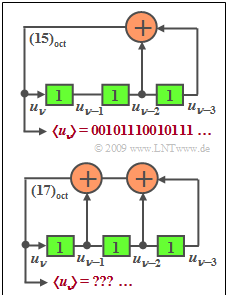Exercise 5.3Z: Realization of a PN Sequence
From LNTwww
The diagram shows two possible generators for generating PN sequences in unipolar representation: $u_ν ∈ \{0, 1\}$.
- The upper generator with the coefficients
- $$ g_0 = 1 \hspace{0.05cm}, \hspace{0.2cm}g_1 = 0 \hspace{0.05cm}, \hspace{0.2cm}g_2 = 1 \hspace{0.05cm}, \hspace{0.2cm}g_3 = 1 \hspace{0.05cm}$$
- is denoted by the octal identifier $(g_3,\ g_2,\ g_1,\ g_0)_{\rm octal} = (15)$.
- Accordingly, the octal identifier of the second PN generator is $(17)$.
- One speaks of an M-sequence if for the period length of the sequence $〈u_ν〉$ holds:
- $$P = 2^G – 1.$$
- Here, $G$ denotes the degree of the shift register, which is equal to the number of memory cells.
Notes:
- The exercise belongs to the chapter Spreading Sequences for CDMA.
- Reference is also made to the chapter Generation of Discrete Random Variables in the book "Theory of Stochastic Signals".
- We would also like to draw your attention to the (German language) learning video
Erläuterung der PN–Generatoren an einem Beispiel ⇒ "Explanation of PN generators using an example".
Questions
Solution
(1) The degree $\underline{G = 3}$ is equal to the number of memory cells of the shift register.
(2) From the given sequence the period length $\underline{P = 7}$ can be read. Because of $P = 2^G –1$ it is an M-sequence.
(3) Solutions 2, 3 and 4 are correct:
- The maximum number of consecutive ones is $G$ (whenever there is a one in all $G$ memory cells).
- On the other hand, it is not possible that all memory cells are filled with zeros (otherwise only zeros would be generated).
- Therefore, there is always one more one than zeros.
- The period length of the last sequence is $P = 2$. For an M-sequence $P = 2^G –1$. For no value of $G$ is $P = 2$ possible.
(4) If all memory cells are occupied with ones, the generator with the octal identifier $(17)$ returns a $1$ again:
- $$u_{\nu} \big [ u_{\nu-1} + u_{\nu-2} + u_{\nu-3} \big ] \,\,{\rm mod} \,\,2 =1 \hspace{0.05cm}.$$
- Since this does not change the memory allocation, all further binary values generated will also be $1$ each ⇒ $\underline{P = 1}$.
(5) Answer 1 is correct:
- One speaks of an M-sequence only if $P = 2^G –1$ holds.
- Here, "M" stands for "maximum".
